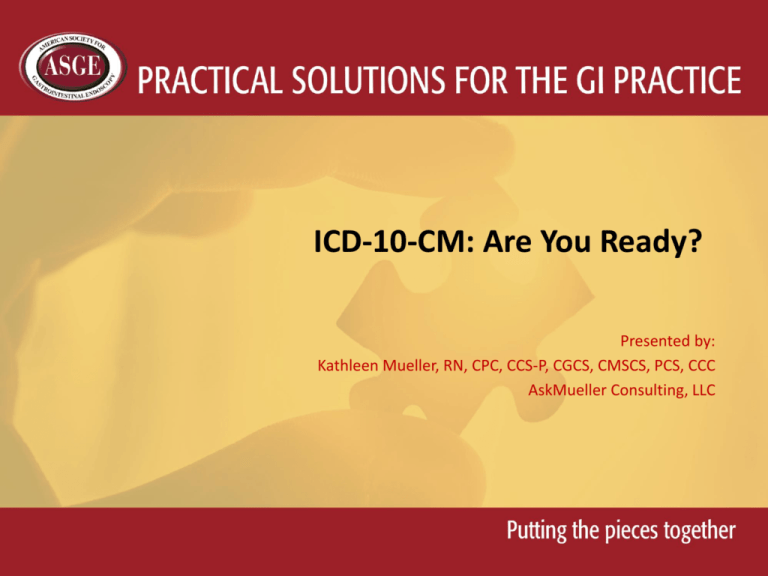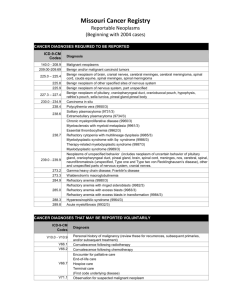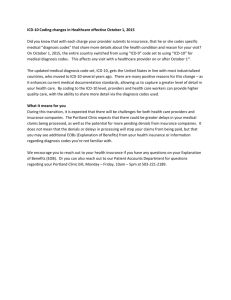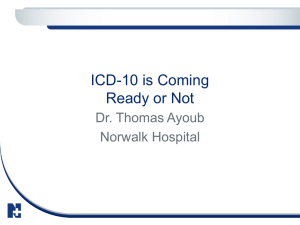ICD-10 The Future of Diagnosis Coding
advertisement

ICD-10-CM: Are You Ready? Presented by: Kathleen Mueller, RN, CPC, CCS-P, CGCS, CMSCS, PCS, CCC AskMueller Consulting, LLC Presenter: Kathleen A. Mueller, RN, CPC, CCS-P, CCC, CMSCS, CGCS President, AskMueller Consulting, LLC CONTACT INFORMATION: 573.332.8348 http://www.askmuellerconsulting.com Disclosure I have no financial interests to disclose. ICD-10 Overview • ICD-9 is no longer supported by the World Health Organization (WHO) – Majority of other countries have already adapted to ICD-10 • ICD-9 can’t accommodate emerging disease affecting us internationally due to lack of specificity • ICD-10 allows for improved disease management • Fewer rejected claims with ICD-10 4 The Comparison ICD-9 ICD-10 14,000+ codes 90,000+ codes 3-5 characters in length 3-7 characters in length Mostly numeric only (E codes/V codes) Character 1-Alpha, Character 2-Numeric, Characters 3-7-Alpha or Numeric Lacks detail Very specific Limited space for new codes Flexible for adding new codes (“x” placeholder) 5 ICD-10 Guidelines • Divided into alphabetic index and the tabular list. – Do not code strictly from the alpha-index – Always confirm your code in the tabular list to verify notes, exclusions, digits required • Format and structure – Tabular list contains categories, subcategories and codes. • All categories are 3 characters: A 3 character category that has no further subdivision is equivalent to a code. • Subcategories are either 4 or 5 characters. • Codes may be 3, 4, 5, 6 or 7 characters. 6 ICD-10 Guidelines Placeholder Character – Placeholder “x” is used to fill in for a code that can be expanded upon in the future. – Usually found in the poisoning, adverse effect and underdosing codes. – Where a placeholder exists, the x must be used in order for the code to be considered a valid code. 7 ICD-10 (Placeholders) • Some codes within ICD-10 assign “X” placeholders for the 4th, 5th, and 6th characters Examples: T88.52XA Failed moderate sedation during procedure, initial encounter T88.52XD Failed moderate sedation during procedure, subsequent encounter T88.52XS Failed moderate sedation during procedure, sequela 8 ICD-10 (7th Character) • Some codes within ICD-10 have a 7th character • Most common for Chapter 19 (Injury/Poisoning) • Most categories give a choice of three options for 7th character: A – initial encounter • Used when the condition or problem is actively being treated during initial encounter (evaluation by new provider) D – Subsequent encounter • Used when the condition or problem is treated during the healing or recovery phase (follow up visits/medication adjustments) S – Sequela encounter • Used for complications or late effects of the condition or problem (chronic) 9 ICD-10 (7th Character) Examples: Initial Encounter Patient presents to ER for food in esophagus causing swallowing problems: 7th T18.128 Food in esophagus causing other injury Since this is the first encounter, A is added: T18.128A Subsequent Encounter • Patient had ERCP with exchange of bile duct stent that was displaced. Patient is following up in the office today and is doing well. 7th T85.520 Displacement of bile duct prosthesis Since this was a subsequent encounter, D is added: T85.520D 10 ICD-10 (7th Character) Examples: Sequela Encounter Patient seen in hospital for elevated transaminase due to intentional acetaminophen overdose: Primary diagnosis would be: R74.8 Nonspecific elevation of levels of transaminase and lactic acid dehydrogenase (LDH) 7th T39.1X2 Poisoning by 4-Aminophenol derivatives, intentional self-harm Since this was a sequela, S is added: T39.1X2S 11 Abbreviations • Alphabetic index: NEC “Not elsewhere classifiable This represents “other specified”. When a specific code is not available for a condition, the Alphabetic Index directs the coder to the “other specified” code in the Tabular List. NOS “Not otherwise specified” This means unspecified. – Tabular List: NEC “Not elsewhere classifiable This represents “other specified”. When a specific code is not available for a condition, the Tabular List includes an NEC entry under a code to identify the code as the “other specified” code. NOS “Not otherwise specified” This means unspecified. 12 ICD-9 versus ICD-10 Right upper quadrant abdominal pain ICD-9: 789.01 ICD-10: R10.11 same Vomiting ICD-9: 787.03 ICD-10: R11.11 without nausea R11.12 projectile RLQ abdominal tenderness ICD-9: 789.63 ICD-10: R10.813 same R10.823 rebound 13 ICD-9 versus ICD-10 Benign neoplasm of colon (colon polyps) ICD-9: 211.3 ICD-10: D12.0 cecum D12.1 appendix D12.2 ascending colon D12.3 transverse colon D12.4 descending colon D12.5 sigmoid colon D12.6 colon, unspecified Adenomatosis of colon Polyposis (hereditary) of colon 14 ICD-10 Structure Tabular List Chapter 1 Certain Infectious and Parasitic Diseases (A00-B99) Chapter 2 Neoplasms (C00-D49) Chapter 3 Diseases of Blood/Blood forming organs/Immune mechanisms (D50-D89) Chapter 4 Endocrine, Nutritional and Metabolic Diseases (E00-E90) Chapter 5 Mental and Behavioral Disorders (F01-F99) Chapter 6 Diseases of the Nervous System (G00-G99) Chapter 7 Disorder of Eye and Adnexa (H00-H59) Chapter 8 Diseases of Ear and Mastoid Process (H60-H95) Chapter 9 Diseases of Circulatory System (I00-I99) Chapter 10 Diseases of Respiratory System (J00-J99) Chapter 11 Diseases of Digestive System (K00-K94) Chapter 12 Diseases of Skin and Subcutaneous Tissue (L00-L99) 15 ICD-10 Structure Tabular List (continued) Chapter 13 Diseases of Musculoskeletal System and Connective Tissue (M00-M99) Chapter 14 Diseases of Genitourinary System (N00-N99) Chapter 15 Pregnancy, Childbirth and Puerperium (O00-O99) Chapter 16 Conditions originating in Perinatal Period (P00-P96) Chapter 17 Congenital Malformations, eformations/Chromosomal Abnormalities (Q00-Q99) Chapter 18 Symptoms, Signs, Abnormal Clinical & Laboratory Findings (R00-R99) Chapter 19 Injury, Poisoning & other Consequences External Cause (S00-T88) Chapter 20 External Causes of Morbidity (V01-Y98) (OLD E CODES) Chapter 21 Factors Influencing Health (Z00-Z99)(OLD V CODES) 16 Infectious and Parasitic Diseases (A00-B99) A04.7 - Enterocolitis due to Clostridium Difficile Foodborne intoxication by Clostridium Difficile Pseudomembranous colitis A09 – Infectious Colitis Infectious colitis NOS Infectious enteritis Infectious Gastroenteritis NOS EXCLUDES 1 colitis NOS (K52.9) diarrhea NOS (R19.7) enteritis NOS (K52.9) gastroenteritis NOS (K52.9) noninfectious gastroenteritis and colitis, (K52.9) 17 Infectious and Parasitic Diseases (A00-B99) Viral Hepatitis (B15-B19) sequalae of viral hepatitis (B94.2) EXCLUDES 1 cytomegaloviral hepatitis (B25.1) EXCLUDES 2 herpes viral [herpes simplex] hepatitis (B00.81) • 4th B18 Chronic viral hepatitis B18.0 B18.1 B18.2 B18.8 B18.9 Chronic viral hepatitis B with delta-agent Chronic viral hepatitis B without delta-agent Chronic (viral) hepatitis B Chronic viral hepatitis C Other chronic viral hepatitis Chronic viral hepatitis, unspecified 18 Neoplasms (C00-D49) Note: Functional activity All neoplasms are classified in this chapter, whether they are functionally active or not. An additional code from Chapter 4 may be used, to identify functional activity associated with any neoplasm. Translation: If there are any metabolic issues documented on pathology, these are to be reported separately. Morphology (Histology) Chapter 2 classifies neoplasms primarily by site, with broad groupings for behavior, malignant, in situ, benign, etc. The table of neoplasms should be used to identify the correct topography code. 19 Neoplasms (C00-D49) Note continued Primary malignant neoplasms overlapping site boundaries A primary malignant neoplasm that overlaps two or more contiguous (next to each other) sites should be classified to the subcategory/code .8 (overlapping lesion), unless the combination is specifically indexed elsewhere. For multiple neoplasms of the same site that are not contiguous, such as tumors in different locations of the large intestine, codes for each site should be assigned. Malignant neoplasm of ectopic tissue Malignant neoplasms of ectopic tissue are to be coded to the site mentioned, e.g., ectopic pancreatic malignant neoplasms are coded to pancreas, unspecified (C25.9). 20 Neoplasms (C00-D49) 1. Treatment directed at the malignancy If treatment is directed at the malignancy, the malignancy is the primary diagnosis. Any secondary sites would be reported as additional diagnosis. 2. Treatment of secondary site When a patient is seen because of a primary neoplasm with metastasis and treatment is directed toward the secondary site only, the secondary neoplasm is designated as the principal diagnosis. Example: Patient is being seen in consultation for carcinoma metastatic to the liver. Diagnosis would be: C78.7 Secondary malignant neoplasm of liver and intrahepatic bile duct 21 Neoplasms (C00-D49) 3. Primary malignancy previously excised When the primary malignancy has previously been excised or eradicated from its site and there is no evidence of any existing primary malignancy, a code from category Z85, Personal history of malignancy neoplasm, should be used to indicate previous site of malignancy. Any mention of secondary malignancy is coded as secondary malignant neoplasm to that site. The secondary site would be the principal diagnosis with the personal history of malignancy as the secondary diagnosis. 22 Neoplasms (C00-D49) 4. Neoplasms of uncertain behavior are only assigned when histologic confirmation of whether the neoplasm is malignant or benign cannot be made. It should not be used in lieu of waiting for pathology report or just because the lesion “looked” funny. 5. Neoplasms of unspecified behavior are those of unspecified morphology and behavior. NOTE: NEOPLASM IS NOT TO BE USED UNLESS THE GROWTH IS NEOPLASTIC IN NATURE. THE TERM MASS DOES NOT MEAN THE MASS IS NEOPLASTIC. 23 Neoplasms (C00-D49) 4th C15 – Malignant neoplasm of esophagus Use additional code to identify: alcohol abuse and dependence (F10.-) Abdominal – C15.5 Cervical – C15.3 Distal (third) – C15.5 Lower (third) – C15.5 Middle (third) – C15.4 Overlapping lesion – C15.8 Proximal (third) – C15.3 Thoracic – C15.4 Upper (third) – C15.3 C15.9 - malignant neoplasm esophagus, unspecified Coding Tips: The neoplasm table in the Alpha index should be referenced first, however, if the histological term is documented such as “adenoma”, that term should be researched to determine whether or not this would be considered a neoplastic process. 24 Diseases of the blood/blood forming organs/Immune mechanisms (D50-D89) D62 – Acute posthemorrhagic anemia anemia due to chronic blood loss (D50.0) EXCLUDES 1 blood loss anemia NOS (D50.0) congenital anemia from fetal blood loss (P61.3) D63.0 - Anemia associated with malignancy Coding tips: When the encounter is specifically for the treatment of the anemia due to malignancy, the appropriate code for the malignancy is sequenced primary, followed by D63.0 25 Endocrine, Nutritional and Metabolic Diseases (E00-E90) 1. Diabetes Mellitus a. Type of diabetes The age of a diabetic is not the sole determining factor, though most type 1 diabetics develop the condition before reaching puberty. For this reason, type 1 diabetes mellitus is also referred to as juvenile diabetes. b. Type of diabetes mellitus not documented If the type of diabetes mellitus is not documented in the medical record, assign E11.-, Type 2 diabetes mellitus c. Diabetes mellitus and the use of insulin If the documentation in the medical record does not indicate the type of diabetes but that the patient uses insulin, Code E11.-, Type 2 diabetes and code Z79.4, Long term (current) use of insulin should be assigned. 26 Endocrine, Nutritional and Metabolic Diseases (E00-E90) 1. Diabetes Mellitus (continued) d. Secondary diabetes mellitus Secondary diabetes is always caused by another condition or even (e.g., cystic fibrosis, malignancy neoplasm of pancreas, pancreatectomy, adverse effect of drug or poisoning) • Secondary diabetes mellitus due to pancreatectomy For postpancreatectomy diabetes mellitus (lack of insulin due to the surgical removal of all or part of the pancreas), assign code E89.1, Postprocedural hypoinsulinemia plus code from category E13 and a code for subcategory Z90.41-, Acquired absence of pancreas. • Secondary diabetes due to drugs For secondary diabetes due to drugs, utilize codes from poisoning or sequeala poisoning 27 Endocrine, Nutritional and Metabolic Diseases (E00-E90) E11.43 Type 2 diabetes mellitus with diabetic autonomic (poly)neuropathy Type 2 diabetes with diabetic gastroparesis E11 subcategory: Use addition code to identify any use of insulin Z79.4 E66.01 Morbid (severe) obesity due to excess calories Excludes 1: morbid (severe) obesity with alveolar hypoventilation (E66.2) E66 subcategory: Use additional code to identify BMI, if known (Z68.-) 28 Endocrine, Nutritional and Metabolic Diseases (E00-E90) • Malnutrition (E40-E46) 4th E44 E46 Protein-calorie malnutrition of moderate and mild degree E44.0 Moderate protein-calorie malnutrition E44.1 Mild protein-calorie malnutrition Unspecified protein-calorie malnutrition Malnutrition NOS Protein-calorie imbalance NOS nutritional deficiency NOS (E63.9) 29 Endocrine, Nutritional and Metabolic Diseases (E00-E90) • 4th E66 Overweight and obesity Code first obesity complicating pregnancy, childbirth and the puerperium, if applicable (O99.21-) Use additional diagnosis code to identify body mass index (BMI), if known (Z68.-) adiposagenital dystrophy (E23.6) EXCLUDES 1 lipomatosis NOS (E88.2) lipomatosis dolorosa [Dercum] (E88.2) Prader-Willi syndrome (Q87.1) 30 Endocrine, Nutritional and Metabolic Diseases (E00-E90) 5th E66.0 E66.1 E66.2 E66.3 E66.8 E66.9 Obesity due to excess calories E66.01 Morbid obesity due to excess calories morbid obesity with alveolar EXCLUDES 1 hypoventilation (E66.2) E66.09 Other obesity due to excess calories Drug induced obesity Use additional code for adverse effect, to identify drug (T36-T50 with 5th or 6th character Morbid obesity with alveolar hypoventilation Overweight Other obesity Obesity, unspecified 31 Mental and Behavioral Disorders (F01-F99) These codes are only to be assigned with provider documentation of a mental or behavioral disorder not just based upon symptoms presented by the patient but by the clinical judgment of the provider. 32 Mental and Behavioral Disorders (F01-F99) F10.229 – Alcohol Dependence with intoxication, unspecified Acute drunkenness (in alcoholism) Excludes 1: alcohol dependence with withdrawal (F10.23-) Coding Tips: If use and abuse are both documented, only code abuse. If both abuse and dependence are both documented, only code dependence. If all three use, abuse and dependence are documented, again only code dependence. 33 Mental, Behavioral, and Neurodevelopmental Disorders (F01-F99) • 4th F50 Eating disorders EXCLUDES 1 anorexia NOS (R63.0) feeding difficulties (R63.3) polyphagia (R63.2) 5th F50.0 Anorexia nervosa EXCLUDES 1 loss of appetite (R63.0) psychogenic loss of appetite (F50.8) F50.00 Anorexia nervosa, unspecified F50.01 Anorexia nervosa, restricting type F50.02 Anorexia nervosa, binge eating/purging type bulimia nervosa (F50.2) 34 Disease of the Nervous System (G00-G99) G47.33 – Obstructive sleep apnea (adult) (pediatric) G89.28 – Other chronic postprocedural pain other chronic postoperative pain Coding Tips: There is no time frame when the pain becomes chronic. Routine or expected postoperative pain should not be coded. 35 Disease of the Nervous System (G00-G99) • 5th G93.4 Other and unspecified encephalopathy alcoholic encephalopathy (G31.2) EXCLUDES 1 hypertensive encephalopathy (I67.4) toxic (metabolic) encephalopathy (G92) G93.40 Encephalopathy, unspecified G93.41 Metabolic encephalopathy Septic encephalopathy G93.49 Other encephalopathy G94 Other disorders of brain in diseases classified elsewhere Code first underlying disease Example: Encephalopathy and primary biliary cirrhosis K74.5 Primary biliary cirrhosis G94 Encephalopathy 36 Disease of the Circulatory System (I00-I99) 4th I12 Hypertensive chronic kidney disease Includes: hypertensive nephropathy nephrosclerosis I12.0 Hypertensive chronic kidney disease with stage 5 chronic kidney disease or end stage renal disease Use additional code to identify the stage of chronic kidney disease (N18.5, N18.6) I12.9 Hypertensive chronic kidney disease with stage 1 through stage 4 chronic kidney disease 37 Disease of the Circulatory System (I00-I99) I25.2 – Old myocardial infarction Healed myocardial infarction Past myocardial infarction diagnosed by ECG or other investigation, but currently presenting no symptoms I48.2 – Chronic atrial fibrillation Permanent atrial fibrillation I69.891 – Dysphagia following unspecified cerebrovascular disease Use additional code to identify the type of dysphagia, if known (R13.1-) 38 Disease of the Circulatory System (I00-I99) 4th I85 Esophageal varices Use additional code to identify: alcohol abuse and dependence (F10.-) 5th I85.0 Esophageal varices Idiopathic esophageal varices Primary esophageal varices I85.00 Esophageal varices without bleeding I85.01 Esophageal varices with bleeding 39 Disease of the Circulatory System (I00-I99) 4th I86 Varicose veins of other sites I86.0 Sublingual varices I86.1 Scrotal varices I86.2 Pelvic varices I86.3 Vulval varices I86.4 Gastric varices I86.8 Varicose veins of other specified sites Varicose ulcer of nasal septum 40 Disease of the Circulatory System (I00-I99) 5th I85.1 Secondary esophageal varices Esophageal varices secondary to alcoholic liver disease Esophageal varices secondary to cirrhosis of liver Esophageal varices secondary to schistosomiasis Esophageal varices secondary to toxic liver disease Code first underlying disease I85.10 Secondary esophageal varices without bleeding I85.11 Secondary esophageal varices with bleeding 41 Diseases of the Respiratory System (J00-J99) 4th J44 Other chronic obstructive pulmonary disease (COPD) Includes: asthma with COPD chronic asthma with obstructive bronchitis chronic bronchitis with emphysema chronic obstructive bronchitis Code also type of asthma, if applicable (J45.-) Use additional code to identify: Exposure to environmental tobacco smoke (Z77.22) History of tobacco abuse (Z87.891) Occupational exposure to environmental tobacco smoke (Z57.31) Tobacco dependence (F17.-) Tobacco use (Z72.0) 42 Diseases of the Respiratory System (J00-J99) 4th J69 Pneumonia due to solids and liquids neonatal aspiration syndrome (P94.-) EXCLUDES 1 postprocedural pneumonitis (J95.4) J69.0 Pneumonitis due to inhalation of food and vomit Aspiration pneumonia Aspiration pneumonia due to gastric secretions Code also any associated foreign body in respiratory tract (T17.-) EXCLUDES 1 chemical pneumonitis due to anesthesia (J95.4) 43 Diseases of the Digestive System (K00-K94) • • • • • • • • • • K00-K14 K20-K31 K35-K38 K40-K46 K50-K52 K55-K64 K65-K68 K70-K77 K80-K87 K90-K95 Diseases of oral cavity and salivary glands Diseases of esophagus, stomach and duodenum Diseases of appendix Hernia Noninfective enteritis and colitis Other diseases of intestines Diseases of peritoneum and retroperitoneum Diseases of liver Disorder of gallbladder, biliary tract and pancreas Other diseases of the digestive system 44 Diseases of the Digestive System (K00-K94) 4th K20 Esophagitis Use additional code to identify: alcohol abuse and dependence (F10.-) erosion of esophagus (K22.1-) EXCLUDES 1 esophagitis with GERD (K21.0) reflux esophagitis (K21.0) ulcerative esophagitis (K22.1-) eosinophilic gastritis or gastroenteritis (K52.81) K20.0 Eosinophilic esophagitis K20.8 Other esophagitis Abscess of esophagus K20.9 Esophagitis, unspecified 45 Diseases of the Digestive System (K00-K94) 4th K21 Gastro-esophageal reflux disease (GERD) K21.0 GERD with esophagitis Reflux esophagitis K21.9 GERD without esophagitis Esophageal reflux NOS 46 Diseases of the Digestive System (K00-K94) 5th K22.7 Barrett's esophagus Barrett’s Esophagus Barrett’s disease Barrett’s ulcer (K22.1) EXCLUDES 1 Malignant neoplasm of esophagus (C15.-) K22.70 Barrett’s Esophagus without dysplasia (Barrett’s Esophagus NOS) 6th K22.71 Barrett's esophagus with dysplasia K22.710 Barrett’s Esophagus with low grade dysplasia K22.711 Barrett’s Esophagus with high grade dysplasia K22.719 Barrett’s Esophagus with dysplasia, unspecified 47 Diseases of the Digestive System (K00-K94) Noninfective enteritis and colitis (K50-K52) 4th K50 Includes: granulomatous enteritis EXCLUDES 1 irritable bowel syndrome (K58.-) Use additional code to identify manifestations, such as pyoderma gangrenosum (L88) 5th K50.1 Crohn’s disease of large intestine Crohn’s disease of colon Crohn’s disease of large bowel Crohn’s disease of rectum Granulomatous colitis Regional colitis EXCLUDES 1 Crohn’s disease of both small and large intestine (K50.8) 48 Diseases of the Digestive System (K00-K94) K50.10 Crohn’s disease of large intestine without complications 5th K50.11 Crohn’s disease of large intestine with complications K50.111 Crohn’s disease of large intestine with bleeding K50.112 Crohn’s disease of large intestine with obstruction K50.113 Crohn’s disease of large intestine with fistula K50.114 Crohn’s disease of large intestine with abscess K50.118 Crohn’s disease of large intestine with other complications K50.119 Crohn’s disease of large intestine with unspecified complications 49 Diseases of the Digestive System (K00-K94) 4th K58 – Irritable Bowel Syndrome Includes: irritable colon, spastic colon K58.0 – Irritable bowel syndrome with diarrhea K58.9 – Irritable bowel syndrome without diarrhea Irritable bowel syndrome NOS K76.6 – Portal Hypertension Use additional code for any associated complications, such as: portal hypertensive gastropathy (K31.89) 50 Diseases of the Digestive System (K00-K94) 4th K64 - Hemorrhoids and perianal venous thrombosis Includes: piles hemorrhoids complicating childbirth and the EXCLUDES 1 puerperium (O87.2) hemorrhoids complicating pregnancy (O22.4) K64.0 – First degree hemorrhoids; grade/stage I; hemorrhoids (bleeding) without prolapse outside of anal canal K64.1 – Second degree hemorrhoids; grade/stage II; hemorrhoids (bleeding) that prolapse with straining, but retract spontaneously K64.2 – Third degree hemorrhoids; grade/stage III; hemorrhoids (bleeding) that prolapse with straining and require manual replacement back inside anal canal K64.3 – Fourth degree hemorrhoids; grade/stage IV; hemorrhoids (bleeding) with prolapsed tissue that cannot be manually replaced 51 Diseases of the Digestive System (K00-K94) K92 Other diseases of digestive system K92.0 Hematemesis K92.1 Melena occult blood in feces (R19.5) EXCLUDES 1 K92.2 Gastrointestinal hemorrhage, unspecified Gastric hemorrhages NOS Intestinal hemorrhage acute hemorrhagic gastritis EXCLUDES 1 hemorrhage of anus and rectum angiodysplasia of stomach with hemorrhage diverticular disease with hemorrhage gastritis and duodenitis with hemorrhage 52 Diseases of the Genitourinary System (N00-N99) 4th N18 Chronic kidney disease (CKD) Code first any associated: diabetic chronic kidney disease (E08.22, E09.22, E10.22, E11.22, E13.22) hypertensive chronic kidney disease (I12-, I13-) N18.1 CKD, stage 1 N18.2 CKD, stage 2 (mild) N18.3 CKD, stage 3 (moderate) N18.4 CKD, stage 4 (severe) N18.5 CKD, stage 5 N18.6 End stage renal disease Chronic kidney disease requiring chronic dialysis Use additional code to identify dialysis status (Z99.2) 53 Pregnancy, Childbirth and Puerperium (O00-O99) Coding Tips: Codes from this chapter are for maternal records only and are never to be used on newborn records. The majority of codes have a final character indicating the trimester of pregnancy: 1st Trimester: less than 14 weeks 0 days 2nd Trimester: 14 weeks 0 days to less than 28 weeks 0 days 3rd Trimester: 28 weeks 0 days until delivery If the pregnancy is incidental to the encounter, then code Z33.1 for pregnancy state, incidental should be indicated 54 Pregnancy, Childbirth and Puerperium (O00O99) 4th O21 Excessive vomiting of pregnancy O21.0 Mild hyperemesis gravidarum M Hyperemesis gravidarum, mild or unspecified, starting before the end of the 20th week of gestation O21.1 Hyperemesis gravidarum with metabolic M disturbance Hyperemesis gravidarum, starting before the end of the 20th week of gestation, with metabolic disturbance such as dehydration Hyperemesis gravidarum, starting before the end of the 20th week of gestation, with metabolic disturbance such as electrolyte imbalance 55 Pregnancy, Childbirth and Puerperium (O00-O99) O21.2 Late vomiting of pregnancy Excessive vomiting starting after 20 completed weeks of gestation. O21.8 Other vomiting complicating pregnancy Vomiting due to diseases classified elsewhere, complicating pregnancy Use additional code, to identify cause O21.9 Vomiting of pregnancy, unspecified M M M M indicates a maternity age Coding Tips: The symbol diagnosis for ages 12-55 only 56 Congenital Malformations, Deformations/ Chromosomal Abnormalities (Q00-Q99) Codes from this chapter may be used throughout the life of the patient. If a congenital malformation or deformity has been corrected, a personal history code should be used to identify the history of the malformation or deformity. Although present at birth, malformation/deformation/or chromosomal abnormality may not be identified until later in life. Whenever the condition is diagnosed by the physician, it is appropriate to assign a code from this chapter. 57 Congenital Malformations, Deformations/ Chromosomal Abnormalities (Q00-Q99) Q39.0 – Atresia of esophagus without fistula Atresia of esophagus NOS Q39.3 – Congenital stenosis and stricture of esophagus Note: K22.2 is used for acquired stenosis and stricture of esophagus Q43.1 – Hirschprung’s Disease Aganglionosis Congenital (aganglionic) megacolon 58 Congenital Malformations, Deformations/ Chromosomal Abnormalities (Q00-Q99) 4th Q44 Congenital malformations of gallbladder, bile ducts and liver Q44.0 Agenesis, aplasia, and hypoplasia of gallbladder Congenital absence of gallbladder Q44.1 Other congenital malformation of gallbladder Intrahepatic gallbladder Q44.3 Congenital stenosis and stricture of bile ducts Q44.4 Choledochal cyst Q44.5 Other congenital malformations of bile ducts Biliary duct duplication Accessory hepatic duct Q44.6 Cystic disease of liver Q44.7 Other congenital malformations of liver 59 Symptoms, Signs, Abnormal Clinical & Lab Findings (R00-R99) • • • • • • R00-R09 R10-R19 R20-R23 R25-R29 R30-R39 R40-R46 • R47-R49 • R50-R69 Involving the circulatory and respiratory system Involving the digestive system and abdomen Involving the skin and subcutaneous tissue Involving the nervous and musculoskeletal systems Involving the genitourinary system Involving cognition, perception, emotional state and behavior Involving speech and voice General signs and symptoms 60 Symptoms, Signs, Abnormal Clinical & Lab Findings (R00-R99) • R70-R79 • R80-R82 • R83-R89 • R90-R94 • R97 • R99 Abnormal findings on exam of blood, without diagnosis Abnormal findings on exam of urine without diagnosis Abnormal findings on exam of other body fluids, tissues without diagnosis Abnormal findings on diagnostic imaging and function studies, without diagnosis Abnormal tumor markers Ill-defined and unknown causes of mortality 61 Symptoms, Signs, Abnormal Clinical & Lab Findings (R00-R99) Coding Tips: Signs, symptoms and abnormal findings are to be used when no definitive diagnosis has been established by the provider. Signs and symptoms that point specifically to a given diagnosis should not be coded. Example: Diarrhea and Irritable Bowel Syndrome are not to be reported separately since there is a combination code of IBS and diarrhea. Example: If the patient is having diarrhea and no diagnosis has been established, then diarrhea should be the primary diagnosis. 62 Symptoms, Signs, Abnormal Clinical & Lab Findings (R00-R99) 4th R10 Abdominal and pelvic pain EXCLUDES 1 renal colic (N23) dorsalgia (M54.-) flatulence and related condition (R14.-) R10.0 Acute abdomen Severe abdominal pain (generalized) (with abdominal rigidity) abdominal rigidity NOS (R19.3) EXCLUDES 1 generalized abdominal pain (R10.84) localized abdominal pain (R10.1-R10.3-) 63 Symptoms, Signs, Abnormal Clinical & Lab Findings (R00-R99) 5th R10.1 R10.2 Pain localized to upper abdomen R10.10 Upper abdominal pain, unspecified R10.11 RUQ pain R10.12 LUQ pain R10.13 Epigastric pain Dyspepsia EXCLUDES 1 functional dyspepsia (K30) Pelvic and perineal pain vulvodynia (N94.81) EXCLUDES 1 64 Symptoms, Signs, Abnormal Clinical & Lab Findings (R00-R99) 5th R10.3 Pain localized to other parts of lower abdomen R10.30 Lower abdominal pain, unspecified R10.31 RLQ pain R10.32 LLQ pain R10.33 Periumbilic pain R10.84 Generalized abdominal pain generalized pain with acute EXCLUDES 1 abdomen (R10.0) 65 Symptoms, signs, Abnormal Clinical & Lab Findings (R00-R99) Example: R19.4 – Change in bowel habits EXCLUDES 1 constipation (K59.0-), functional diarrhea (K59.1) R74.0 – Nonspecific elevation of levels of transaminase and lactic acid dehydrogenase (LDH) R93.3 – Abnormal findings on diagnostic imaging of other parts of the digestive tract 66 Injury, Poisoning, & other Consequences of External Causes (S00-T88) T18.128A Food in esophagus causing other injury, initial encounter Bones in esophagus Seeds in esophagus T18.2XXA – Food in stomach, initial encounter T88.52XA – Failed moderation sedation during a procedure Failed conscious sedation during procedure personal history of failed moderate EXCLUDES 1 sedation (Z92.83) 67 External Causes of Morbidity (V01-Y98) • These codes are secondary and never primary codes. • These codes are intended to provide data for injury research and evaluation of injury prevention strategies. These codes capture how the injury or health condition happened (cause), the intent (unintentional or accidental; or intentional, such as suicide or assault), the place where the event occurred, the activity of the patient at the time of the event, and the person’s status (e.g., civilian, military). • These codes should be used for the length of treatment • External codes for child and adult abuse take priority over all other external cause codes • External cause codes for terrorism take priority over all other external cause codes except child and adult abuse 68 External Causes of Morbidity (V01-Y98) Y63.6 – Underdosing and nonadministration of necessary drug, medicament, or biological substance Y90 Evidence of alcohol involvement determined by blood alcohol level Code first any associated alcohol related disorders (F10) Y90.0 - BAL of less than 20mg Y90.1 - BAL of 20-39mg Y90.2 - BAL of 40-59mg Y90.3 - BAL of 60-79mg Y90.4 - BAL of 80-99mg Y90.5 - BAL of 100-119mg Y90.6 - BAL of 120-199mg Y90.7 - BAL of 120-199mg Y90.8 - BAL of 200-239mg Y90.9 - BAL of 240mg of more 69 External Causes of Morbidity (V01-Y98) Example: Don came in to the ER after being found at the bus station unconscious due to alcohol toxicity with level of 270. Primary diagnosis would be: T51.0X4A Toxic effect of ethanol, undetermined, initial encounter Secondary diagnosis would be: Y90.9 BAL of 240mg of more Y92.521 Bus station as the place of occurrence of the external cause 70 Factors Influencing Health Status (Z00-Z99) • • • • • • Z00-Z13 Z14-Z15 Z16 Z17 Z18 Z20-Z28 • Z30-Z39 Persons encountering health services for examinations Genetic carrier and genetic susceptibility to disease Resistance to antimicrobial drugs Estrogen receptor status Retained foreign body fragments Persons with health hazards related to communicable diseases Persons encountering health services related to reproduction 71 Factors Influencing Health Status (Z00-Z99) • Z40-Z53 • Z55-Z65 • • • • Z66 Z67 Z68 Z69-Z76 • Z77-Z99 Encounters for other specific health care Persons with potential health hazards related to socioeconomic and psychosocial circumstances Do not resuscitate status Blood type Body mass index (BMI) Persons encountering health services in other circumstances Persons with potential health hazards related to family and personal history and certain conditions influencing health status 72 Factors Influencing Health Status (Z00-Z99) • These codes are used when a person who may or may not be sick encounters the health services for some specific purpose, such as to receive limited care for a current condition, to donate an organ, to receive prophylactic vaccination, or receive a screening procedure/service. • These codes can also be used when the circumstance or problem is present which influences the person’s health status but is not in itself a current illness or injury. Such as personal or family history situations. 73 Factors Influencing Health Status (Z00-Z99) 4th Z12 Encounter for screening for malignant neoplasms Note: Screening is the testing for disease or disease precursors in asymptomatic individuals so that early detection and treatment can be provided for those who test positive for the disease Z12.0 Screening of stomach 5th Z12.1 Screening of intestinal tract Z12.11 Screening of colon Encounter for screening colonoscopy Z12.12 Screening of rectum Z12.13 Screening of small intestine 74 Factors Influencing Health Status (Z00-Z99) Z23 Encounter for immunization Code first any routine childhood examination Note: Procedure codes are required to identify the types of immunizations given Z48.23 Encounter for aftercare following liver transplant 75 Factors Influencing Health Status (Z00-Z99) 4th Z79 Long term (current) drug therapy Includes: long term (current) drug use for prophylactic purposes Code also any therapeutic drug level monitoring (Z51.81) Z79.0 Anticoagulants and antithrombotics/antiplatelets Z79.01 Anticoagulants Z79.02 Antithrombotics/antiplatelets Z79.1 – Long term (current) use of non-steroidal antiinflammatories (NSAID) long term (current) use of aspirin (Z79.82) EXCLUDES 1 76 Factors Influencing Health Status (Z00-Z99) 4th Z85 Personal history of malignant neoplasm Code first any follow-up examination after treatment of malignancy neoplasm (Z08) Use additional code to identify: alcohol use and dependence Example: 5th Z85.0 Personal history of malignant neoplasm of digestive organs 6th Z85.04 Personal history of malignant neoplasm of rectum Z85.040 Personal history of malignant carcinoid Z85.048 Personal history of other malignant neoplasm 77 Preparing your Providers • Providers need to be more specific in their documentation – Identify errors and nonspecific code use – Train each provider based on current lack of specificity and errors in your ICD-9 system and continue into ICD-10. • Improving documentation will support medical necessity – Documentation is often requested by payers to ensure medical necessity is met • Better quality and accurate medical record – Decrease in claim denials • Improved documentation and accurate medical records translate into good patient care • Documentation is not just a billing tool but a medical legal document. Accuracy is a must. 78 Preparing your Coders & Billers • Anatomy and ICD-10 training sessions for Coders • Don’t forget your Billers, Schedulers, Clinicians, Managers, Administrators and other staff members. I encourage you to share this with all members of your team to ensure proper selection of codes according to specificity based on the documentation in the medical record. Specificity is the key to preauthorization of services. Specificity is the key to timely payment of services. Lack of specificity in both procedure and evaluation & management records can stall payments as well as trigger claims reviews before payment is rendered. • Coders must retest to maintain certifications – Certified coders are given 2 years to pass ICD-10 exam – Test will be open book and online 79 ICD-10 Conclusions • Reimbursement – If we continue to use unspecified diagnosis codes, we could see claim denials (Many payers have informed practices/organizations that denial of non-specific diagnosis codes will become routine after October 1, 2015.) The average cost of a denied claim per MGMA statistical analysis is $40. • Improvement of medical record documentation – Medical necessity results in fewer claim denials – Improve quality of patient care – Less likely a target for the OIG, RAC or ZPICS audits • Better quality of data analysis and research 80




